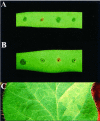Cultivar-specific avirulence and virulence functions assigned to avrPphF in Pseudomonas syringae pv. phaseolicola, the cause of bean halo-blight disease
- PMID: 10880434
- PMCID: PMC313945
- DOI: 10.1093/emboj/19.13.3204
Cultivar-specific avirulence and virulence functions assigned to avrPphF in Pseudomonas syringae pv. phaseolicola, the cause of bean halo-blight disease
Erratum in
- EMBO J 2000 Nov 1;19(21):5941
Abstract
The avrPphF gene was cloned from Pseudomonas syringae pathovar phaseolicola (PPH:) races 5 and 7, based on its ability to confer avirulence towards bean cultivars carrying the R1 gene for halo-blight resistance, such as Red Mexican. avrPphF comprised two open reading frames, which were both required for function, and was located on a 154 kb plasmid (pAV511) in PPH: Strain RW60 of PPH:, lacking pAV511, displayed a loss in virulence to a range of previously susceptible cultivars such as Tendergreen and Canadian Wonder. In Tendergreen virulence was restored to RW60 by avrPphF alone, whereas subcloned avrPphF in the absence of pAV511 greatly accelerated the hypersensitive resistance reaction caused by RW60 in Canadian Wonder. A second gene from pAV511, avrPphC, which controls avirulence to soybean, was found to block the activity of avrPphF in Canadian Wonder, but not in Red Mexican. avrPphF also conferred virulence in soybean. The multiple functions of avrPphF illustrate how effector proteins from plant pathogens have evolved to be recognized by R gene products and, therefore, be classified as encoded by avirulence genes.
Figures







References
-
- Bonas U. and Van den Ackerveken,G.F.J.M. (1997) Recognition of bacterial avirulence proteins occurs inside the plant cell: a general phenomenon in resistance to bacterial diseases? Plant J., 12, 1–7. - PubMed
-
- Bonas U., Stall,R.E. and Staskawicz,B. (1989) Genetic and structural characterisation of the avirulence gene avrBs3 from Xanthomonas campestris pv. vesicatoria. Mol. Gen. Genet., 218, 127–136. - PubMed
-
- Boyer H.W. and Roulland-Dussoix,D. (1969) A complementation analysis of the restriction and modification of DNA in Escherichia coli. J. Mol. Biol., 41, 459–472. - PubMed
Publication types
MeSH terms
Substances
LinkOut - more resources
Full Text Sources
Other Literature Sources

